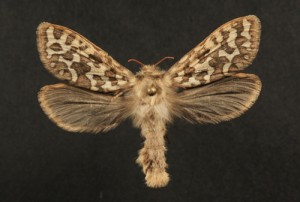This moth is just about as rare as its paranormal namesake (except that it’s real) – it’s a Gazoryctra sp. in the family Hepialidae. They represent a basal lineage of the Lepidoptera and are commonly known as ghost moths or swift moths. Ghost – because males of some species are known to fly in true leks, where they hover up and down in grassy clearings at dusk while females observe. These same males also call for females with pheromones, a bit of a backward situation with insects. Swift- rather self evident, but boreal species have been known to be powerful flyers.
One of the features that help indicate this as a basal lineage is the placement of the wings on the body, some wing venation, reduced or absent mouthparts and the lack of a strong wing coupling device. These moths have a “jugum”, which is a small thumb like projection from the top of the hindwing. Other lineages of moths have a tight coupling mechanism known as the frenulum and retinaculum, where bristles hook the two wings together so they remain coupled during flight. When at rest the jugum folds around and probably helps keep the wings together – but not while in flight; the forewing is out of sync with the hindwing and flight is not dynamic (Scoble 1992).
In the Americas Hepialid biology is very poorly understood. Only a handful of life histories are described globally – all of which seem to be endophagous (boring) in plant root systems. Some early instar larvae may feed in the leaf litter or underground on the root system before entering the rhizome. Australia is fortunate to have a diverse and impressive fauna of Hepialidae – many are brilliantly colored and enormous (250mm or up to 12 అంగుళాలు!), and a bit better studied. Some larvae are even common enough that aboriginal tribes have used them as a staple food source.
But back to this moth in particular. I collected it in my black light trap last August up in the Sierra Nevada around 10,500 feet. The species is unknown, and may likely be new. The most frustrating part is that it is the only specimen known to science. The entire genus is very rare, except for one or two commoner species, only a few dozen specimens exist. So is it a female of a species described only from a male? A freakish aberration of an otherwise known species? Or maybe it is actually new. I’ve barcoded the DNA, that actually tells me nothing since there are zero sequences from any closely related species. నిజంగా, as far as I know, the other species in the Sierra haven’t even been collected in decades so I can’t even get a sequence from an older specimen. The icing on the cake is their behavior. They rarely, ఎప్పుడైనా, come to light – which may be a result of their crepuscular flight. On the right night they may be on the wing for 20-30 minutes, usually a female searching out a male, or a female flying to oviposit (likely just broadcast scatter their eggs on the ground). So come this late August I’ll be returning to the high Sierra with a few volunteers from the entomology department in hopes of seeing one whiz by me on the steep slopes. If I get some more, it might turn out to be impressive new species for California.


A similar situation to the beetle I talked about in this post – a lonely singleton that must sit in a cabinet unnamed until (ఆశాజనక) another specimen or two turn up.
Reduced or absent mouthparts a basal character – makes it sound like mouthparts didn’t evolve until after the main holometabolous orders had diversified. 🙂
వావ్, how cool! Hopefully you’ll nab another one or two!
Yo, క్రిస్. I sent you a reply to your e-mail. Hope my pic attachment didn’t stall the message in spam. When’s the next Moth and Me?
[…] was on the quest for more specimens of a new Hepialidae of which you may be familiar with from an earlier post. I heard reports from others that at elevations of 11,000′+ there was still a significant […]
[…] Moth has joined the Southern Fried Science Network. This blog boasts a great combination of entomology, photography, field work, and skepticism. Go check it out for sure, and welcome Chris to the […]
[…] Now I haven’t started blogging about music (for those who get the Wilco reference), but I am taking us back to the ghost moth of previous posts. […]